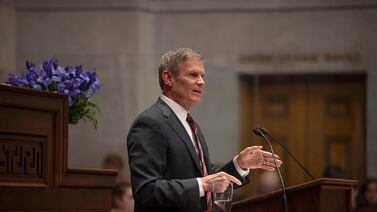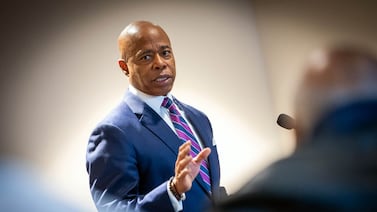New Jersey’s Head Start and Early Head Start programs, key partners in the state’s public preschool efforts, have been struggling to keep up enrollment in the face of federal funding limits.
Such is the latest finding from the National Institute for Early Education Research at Rutgers University, which this month released its report on Head Start and Early Head Start programs in all 50 states.
The report examined the status of the programs across the country and found that “insufficient funding has limited the programs’ ability to deliver these services to all eligible children and families, hampering progress over the last decade.”
And while New Jersey has one of the more aggressive preschool efforts in the country, the report found its federally funded Head Start and Early Head Start programs have not necessarily shared in that success.
In New Jersey, just 33% of eligible children in poverty were enrolled in Head Start and just 11% in Early Head Start in the 2020-21 school year, the report said. Overall, the national average for Head Start enrollment was about 30%. North Dakota had the highest share (56%) and Washington D.C. the lowest (6%).
Deeper dive into the numbers
New Jersey’s lackluster showing may have another explanation, however. The state has its own preschool program for 3- and 4-year-old students in dozens of its poorest districts, but the NIERR report does not factor in those programs, which could be picking up a good share of those Head Start-eligible students.
According to the NIERR report, 24% of 3-year-olds and 41.8% of 4-year-olds overall were enrolled in public early childhood education in New Jersey in 2020-21 — ranking 5th and 20th, nationally. Moreover, New Jersey ranked second in state and other spending for public early childhood education.
But unlike Head Start and Early Head Start, the state Department of Education doesn’t provide preschool enrollment data by family income, so there is no way to know the percentage of eligible infants, toddlers, and children that are enrolled in some sort of program.
Getting a handle on Head Start
The Head Start and Early Head Start programs, first established in 1965, offer child development services for low-income families, focusing on early learning and development, health and wellness, and family well-being and engagement.
Early Head Start provides services for children from birth to age 3 and Head Start preschool services work with children from ages 3 to 5. Eligible families — those that meet the federal poverty requirement — receive these services at no cost.
Yet the programs have struggled in recent years. Nationally, NIEER found that fewer than half of 3- and 4-year-olds in poverty were enrolled in Head Start programs in 2018-19, even before the pandemic. That 41% declined further after COVID-19 struck, all but shutting down their facilities, to just 30% of eligible 3- and 4-year-olds.
“It’s inexcusable that nearly 60 years after its founding, Head Start can’t reach even half the eligible children, even as child poverty hits historic lows,” said Steven Barnett, a senior co-director and founder of NIEER.
In New Jersey, Head Start programs also haven’t made much progress. In 2011-12, 37% of eligible children were enrolled in Head Start, and that fell to the 33% in 2020-21. More than 5,000 fewer children were served in the 2020-21 school year than a decade earlier, said Allison Friedman-Krauss, an assistant research professor at the Rutgers Graduate School of Education and the lead author of the NIEER report.
Friedman-Krauss did credit New Jersey as a national leader overall in its broader approach to early education.
Head Start and Early Head Start are just a small portion of the picture in New Jersey’s public early education. The state’s court-ordered Abbott preschool program ensures 30 high-poverty school districts offer two years of full-day high-quality preschool.
Overall, Gov. Phil Murphy has increased funding for preschool expansion for the past five years. In the current budget for the 2023 fiscal year, Murphy added $68 million in state preschool aid, with $40 million designated to expand preschool into new districts.
With these steps and programs in place, Friedman-Krauss said New Jersey has a lot going for it. In this “mixed-delivery” approach, in which public schools partner with outside organizations or programs like Head Start, she said more children can be served adequately and with quality.
“They can make the Head Start dollars go further by partnering (and) combining those two funding streams, and many of the Abbott districts have been doing this very successfully for 20 or so years,” she said.
The NIEER’s Barnett added, “Governor Murphy takes a giant step toward making New Jersey’s high-quality public preschool program available to every child and family, which will produce benefits for decades to come.”
Representation by race
NIEER also reports variations in enrollment and quality of programs across states by race. Nationally, a higher percentage of Black children are enrolled in Head Start than white children — 33% and 25%, respectively. However, Head Start funding per child is lower in states that enroll a higher percentage of Black children, and performance measures were also lower.
In New Jersey, 34% of eligible Black children in poverty are enrolled in Head Start and 11% of eligible Black children are enrolled in Early Head Start. The proportion of eligible Black children served is the highest of any race in the state. Yet New Jersey’s federal funding per child is among the lowest in the country when adjusted for cost of living.
“There’s an outdated funding formula that’s been used to say how much money goes to each state and the grantees and it hasn’t been updated to reflect the population, the changing population in the states, which is, I think, why we see such an imbalance in the per child funding amounts across the states,” Friedman-Krauss said.
“And New Jersey is on the low side. They’re below the national average, yet they are one of the more expensive states to provide Head Start in.”
More dollars needed
The NIEER report concludes with a simple suggestion: More funding.
In 2020-21, the federal government allocated $10.5 billion across the United States in funds for the program. NIEER indicates that this amount should be more than doubled, estimating that the total funding needed to adequately address the low enrollment and inequalities in access and quality is $22.8 billion.
In part, NIEER recommended additional funding for teachers and staff. While requirements to teach in these programs have been raised, salaries have not. Friedman-Krauss said that this additional funding would allow Head Start to acquire and retain more qualified educators.
“To really bring all the states up, or all the programs up to where they need to be, just requires funding,” she said. “And a big part of that is to push for pay parity for the teachers to attract and retain qualified, educated teachers.”
Leaders at the Gateway Community Action Partnership — which runs Head Start and Early Head Start programs throughout Atlantic, Cape May, Cumberland, Gloucester, Salem, and Mercer counties — say staffing is a big issue and programs started the year understaffed by 25%.
“Programs throughout the state have expressed concerns about staff vacancies and turnover, in large part due to low wages,” said Bonnie Eggenburg, vice president of Head Start and Early Head Start for the Gateway Community Action Partnership. “Compensation for the early childhood workforce, including Head Start, ranks in the lowest 10% of professions.”
She emphasized the need for adequate Head Start teachers that make these child development services effective and beneficial for the children and families enrolled.
“Gateway Head Start staff inspire our families, motivate our children to learn and work every day to provide high-quality early education services to children,” she said. “They are essential to the success of the Head Start program, and essential to supporting a comprehensive, mixed-delivery system for early childhood services in New Jersey. The best way we can equitably serve children and families striving to improve their quality of life is to ensure robust funding and compensation for qualified Head Start educators.”
Michael Pappano is an intern with NJ Spotlight News, where this story was first published. NJ Spotlight News is a content partner of Chalkbeat Newark.








